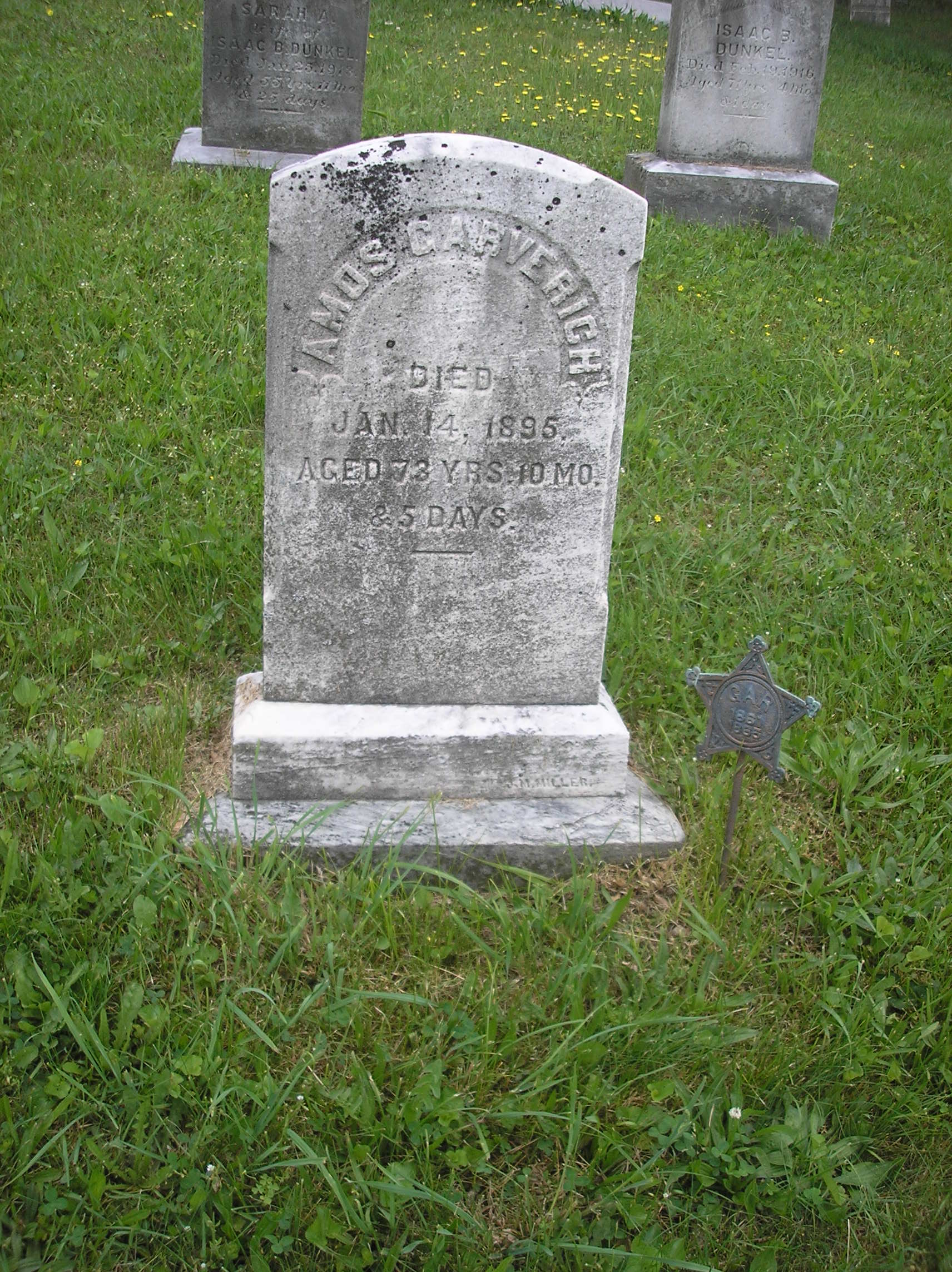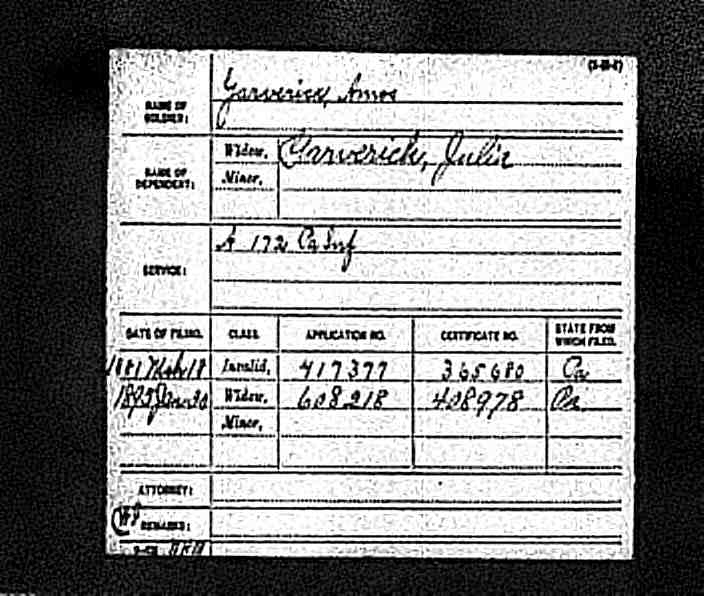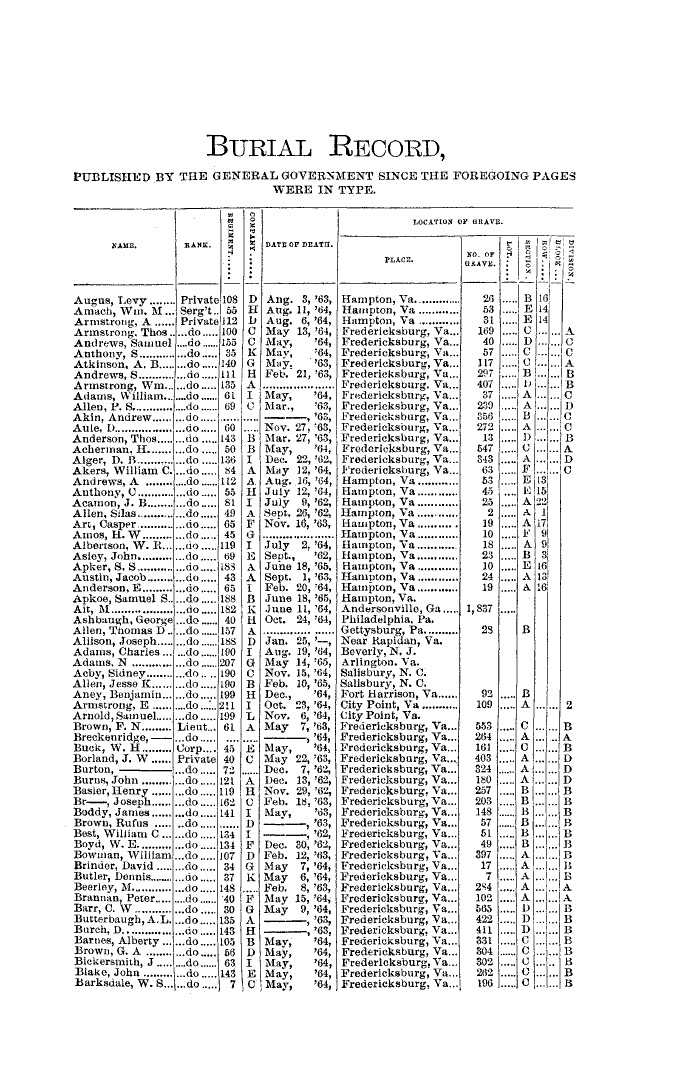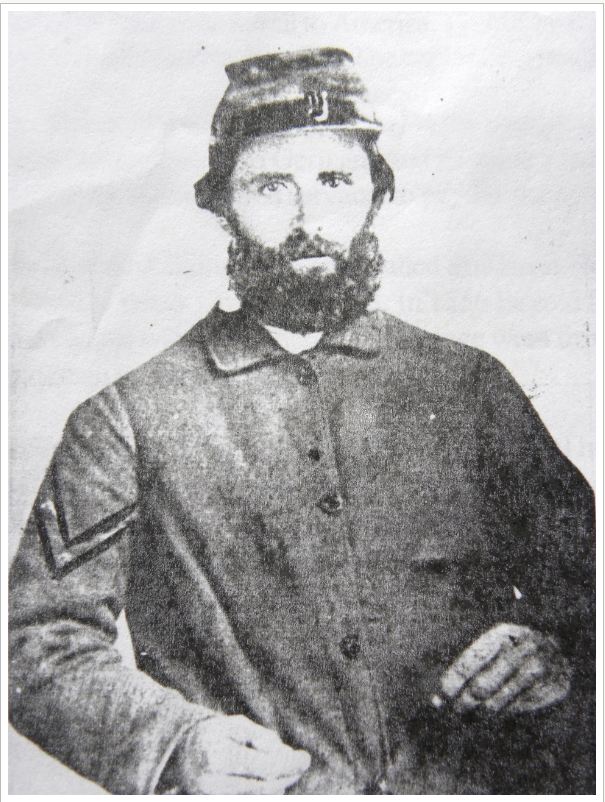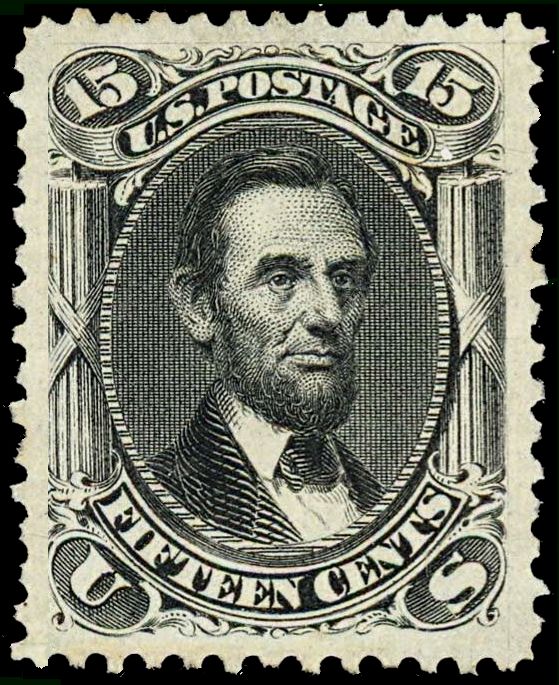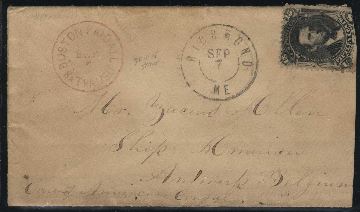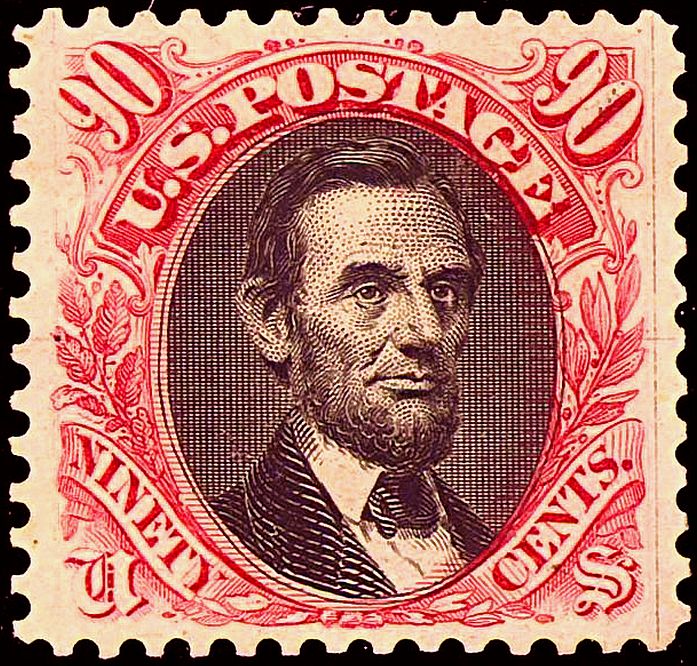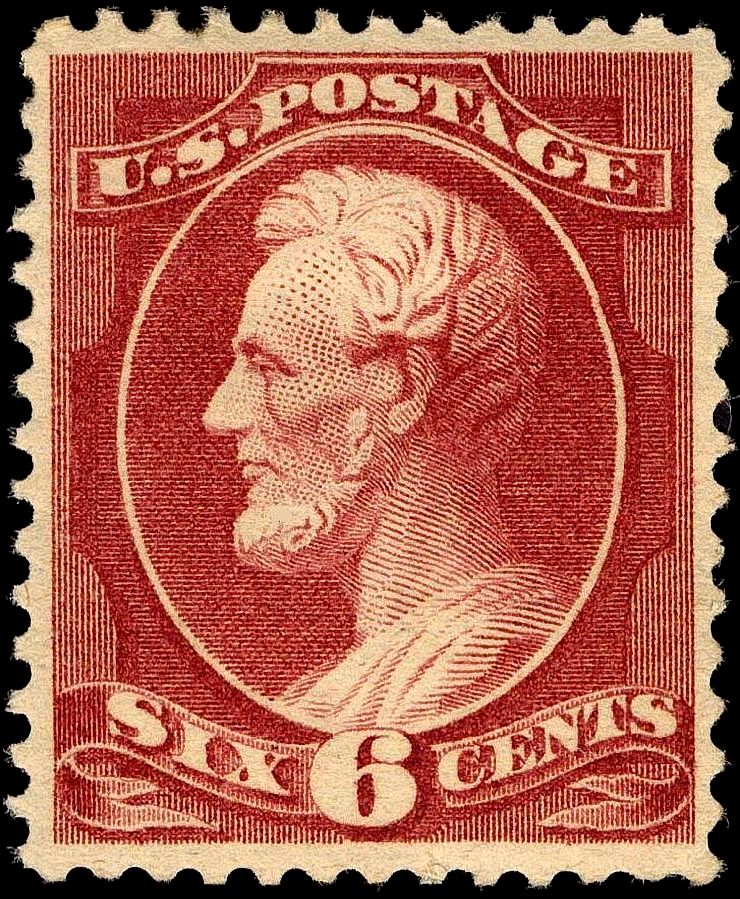Posted By Norman Gasbarro on January 15, 2013
John Peter Crabb was born in Gratz, Dauphin County, Pennsylvania, in October 1843, the son of Peter Crabb and his wife Mary Magdalena Crabb. The Peter Crabb family arrived in Gratz in the early part of the 19th century and purchased land from Simon Gratz. John Peter Crabb, like his father, was a skilled blacksmith. When the Civil War began, John Peter Crabb was a member of the Gratztown Militia, the group of hometown defenders who were called into action to defend the state during the 1863 Emergency [he is named as “Peter Crabb” in the company listing, 36th Pennsylvania Infantry (Emergency of 1863), Company C]. However, because he was an African American, he was not permitted to join a regiment that was sent into national service – until Abraham Lincoln allowed it – and then, his service was only welcome in segregated regiments. John Peter Crabb then joined the 24th U.S. Colored Troops, Company B, and probably because of his previous military experience, was made a Corporal. After the Civil War, John Peter Crabb returned to Gratz where he married Annie Engleman in 1866. He continued at his blacksmith trade in the Lykens Valley until the late 1870s, at which time he moved to Harrisburg.
In researching another member of the 24th U.S. Colored Troops, Sergeant Lloyd F. A. Watts, many news articles were discovered which told of the post-war activities of John Peter Crabb. What was not known until those articles were discovered was that John Peter Crabb was involved in Republican Party politics and was active in the G.A.R. – participating in every Memorial Day parade and tribute to his fallen comrades. The articles that were found are presented below in chronological order – with excerpts from the text of the article as the story line. They present a fascinating picture of a leading citizen of Harrisburg – a founder of one of the only “colored” G.A.R. posts in Pennsylvania, if not in the nation – serving as its commander for a time and always one who was seen as the leader – lobbying for pension rights, riding on horseback at the front of parades, and living and working in Harrisburg’s 8th Ward very near the old capitol building.
The story begins at the Dauphin County Fair of 1880:
—————————–
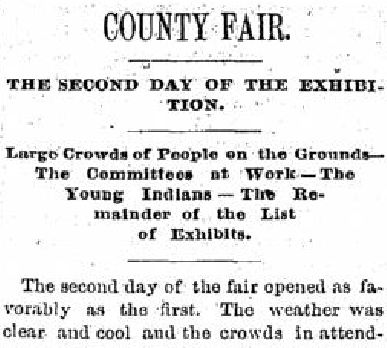
Harrisburg Patriot. 23 September 1880. Dauphin County Fair. The Second Day of the Exhibition. Large Crowds of People on the Grounds. The Remainder of the List of Exhibits.
The second day of the fair opened as favorably as the first. The weather was clear and cool and the crowds in attendance aggregated about seven thousand people. The street cars and conveyances to and from the park were literally packed with people…. The exhibits were completely arranged yesterday morning when the committees made their appearances in the several departments…. Messrs. Hiester and Stephen, as well as all the officers on the ground, deserve credit for the excellent management in the disposition of places for exhibits to the satisfaction of all exhibitors, and for the good order maintained on the ground throughout the day….
Miscellaneous Articles. John P. Crabb, Harrisburg, display of hand made horse shoes….
——————————
Harrisburg Patriot. 25 January 1881. Republican Aspirants. A List From Which Candidates Will Be Chosen.
The following is the list made up at the republican naming meeting on Saturday night from which the candidates of that party will be selected on Saturday evening:….
Eighth Ward, First Precinct – Delegates, Spencer P. Irvin, C. W. Harley, T. H. Thompson, George W. Krause, Samuel Bennett; select council, George W. Stoner; common council, P. H. Ryan, C. A. Miller, John A. Krause, Charles Weaver, A. H. Frankem, Joseph B. Popel, Jacob Camp, Alfred Garner; school director, Amos W. Young, William H. Day, James Templar; assessor, John W. Simpson, George Douglass; constable, C. W. Harley, William R. Dorsey, James Hunter; judge of election, J. P. Crabbe; inspector, James H. Howard, L. V. Early, Thomas Thompson.
——————————
Harrisburg Patriot. 1 November 1881. Named for Councilman.
The republicans of the eighth ward assembled at the McDonnell House on East State last night for the purpose of placing in nomination a candidate for councilman. Three names were handed in, Joseph H. Popel, John P. Crabb and Charles S. McCullough for the executive committee of the ward to select a candidate from this evening….
—————————–
Harrisburg Patriot. 31 January 1887. Named by Republicans. Persons Nominated on Saturday Night to be Voted for a Week Hence.
The republicans named on Saturday night for the city convention and common council are as follows:….
Eighth Ward… Second Precinct – Joeph B. Popel, John P. Crabb, John Highland, Frederick Thomas, Frank Bennett,William Taylor, Samuel Popel, Charles Howard, John Cash, David Robinson….
——————————-
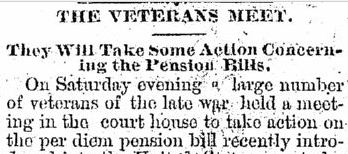
Harrisburg Patriot. 16 April 1888. The Veterans Meet. They Will Take Some Action Concerning the Pension Bills.
On Saturday evening a large number of veterans of the late war held a meeting in the court house to take action on the per diem pension bill recently introduced into the United States Senate by Senator Cameron. An organization was effected by the election of Colonel Owen Hamilton, President, and A. B. Price, Esq., Secretary. Colonel Hamilton then stated the object of the meeting, and after the question had freely discussed, a resolution was adopted for the appointment of a committee of three veterans from each war to canvass their respective wards and bring out all the old soldiers at the next meeting, in order to have a full and fair interchange of views on the matter in question. The following committee was appointed….
Eighth Ward – John C. Nutt, C. W. Harley, J. P. Crabb….
——————————
Harrisburg Patriot. 26 June 1888. Chief Marshal’s Orders. The Republican Ratification Parade. Change of Route.
Marshals of organizations will be governed by following line formation….
The following appointments are announced: Special aids, Major Oliver H. Simmons and Harry Bach. Aids – F. M. Eastman, F. M. Ott, W. E. Barnes, Nelson Hoffman, George B. Fleming, Charles C. Steiner, James Smith, W. H. Butler, Charles Barnes, J. P. Crabb, A. H. Boyer, W. O. Fox, and John Robertson. They will report (mounted) to chief marshal at Lochiel Hotel at 7:30 p.m.
Marching clubs will march according to orders of respective marshals. Other organizations will march in columns of fours.
It is earnestly requested that all citizens residing along the route, who are favorably dispose, will testify their approbation by illuminating and liberal display of bunting, etc….
—————————-
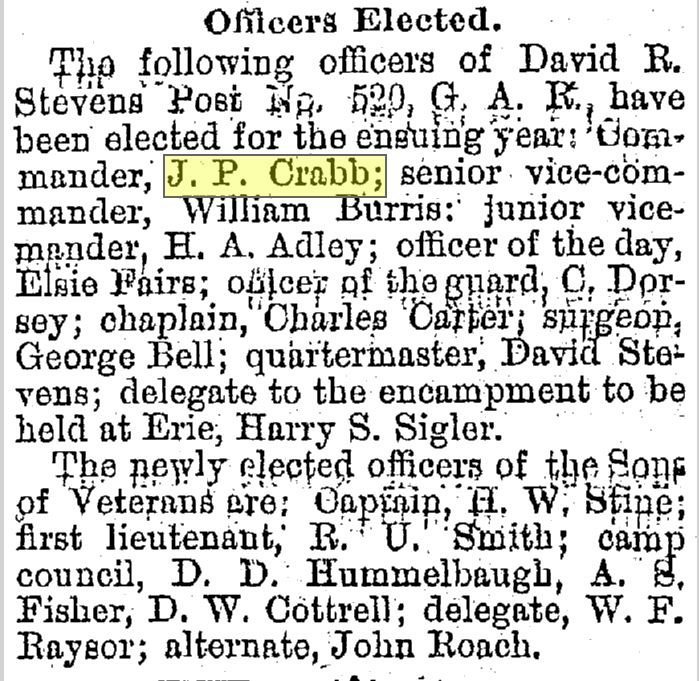
Harrisburg Patriot. 7 December 1888. Officers Elected.
The following officers of David R. Stevens Post No. 520, G. A. R., have been elected for the coming year” Commander, J. P. Crabb; Senior Vice Commander, William Burris; Junior Vice Commander, E. A. Adley; Officer of the Day, Elsie Fairs; Officer of the Guard, C. Dorsey; Chaplain, Charles Carter; Surgeon, George Bell; Quartermaster, David Stevens; Delegate to the Encampment to Be Held at Erie, Harry S. Sigler.
The newly elected officers of the Sons of Veterans are: Captain, H. W. Stine; First Lieutenant, R. U. Smith; Camp Council, D. D. Rummelbaugh, A. S. Fisher, D. W. Cottrell; Delegate, W. F. Raysor; Alternate, John Roach.
—————————
Harrisburg Patriot. 30 May 1889 Honoring the Dead. How Memorial Day Will Be Observed in Harrisburg.
The arrangements for the observance of Memorial Day here were completed by Post 116, Grand Army of the Republic, yesterday, and with Samuel Montgomery, of that post, as Chief Marshal, the parade will be formed at 2 o’clock this afternoon, in two divisions, and move as follows:
First Division – Samuel Eberly, Assistant Marshal; F. R. Mathers and William Lukens, Aids; Middletown Cornet Band; advance guard, Post 116, John R. Boyle, commanding; Colonel S. G. Simmons Post, J. Jr. Reese, Commander; artillery of Post 116, John R. Boyle, Commanding. Assistant Marshal, W. A. Washington, Post 520; Aids, G. W. Thomas and Richard Shaw; Portsmouth Band, Middletown; advance guard, Post 520, Harry S. Ziegler, Commanding; David R. Stevens Post, No. 520, J. P. Crabb, Commanding; Camp No. 141, Sons of Veterans, Captain J. E. Scott, commanding.
Second Division – ….
The parade will form on East Broad Street, right resting on Third and proceed out Broad to Front, Front to Calder, Calder to Third to Reily, Reily to Fourth, Fourth to Harris, Harris to Ridge, Ridge to Broad, Broad to Elder, Elder to Boas, Boas to Second, Second to State, to capitol, and out State to cemetery.
The exercises at the Harrisburg Cemetery will be as follows: G. A. R. services by comrades of Post 116; dirge by the band; strewing of flowers by comrades of Post 116 assisted by the Ladies’ Circle, No. 17 and school children; “My Country ‘Tis of Thee,” will be sang by the school children; salute by the advance guard; salute by post artillery; taps; oration by W. H. Fishburn; benediction.
The school children will be formed in two ranks under the direction of the Ladies’ Circle, No. 17, at the post room at 2 o’clock sharp.
—————————

Harrisburg Patriot. 31 May 1889. The Cities of the Dead. Observance of Memorial Day in This City. Graves Decorated. The Grand Army Posts and Other Organizations Parade – Flowers are Strewn on the Mounds – Exercises in the Opera House
The sun, which comes up early these pretty May mornings, was hid behind a cloud when Memorial Day was born, and its rays fell not on the flowers that were plucked “before the dew could wet their thirsty petals through.” Nevertheless the streets were thronged early in the day and far into the night, and the event was generally observed.
In the morning the graves of the soldier dead were decorated and in the afternoon services were held by the Grand Army posts at the Harrisburg Cemetery and by the Union Veterans’ Union at the soldiers’ monument, Second and State.
Post No. 58 formed its procession on Market Street at 2 o’clock with Captain A. G. Cummings as Chief Marshal. The right rested on Front and at the command countermarched down Market to Fifth in the following order: Governor’s Troop (mounted). Hummelstown Band. City Grays in dress uniform, gray coats, white trousers and shakos. City Grays’ Drum Corps. City Grays’ Cadet Corps in dress uniform. Perseverance Council, No. 12, O. U. A. M. Citizens’ Band of Mechanicsburg. Post 56, G. A. R. divided into three companies, A, B, and C, under command of Captain J. W. Meese. Vehicles containing flowers. Carriages with disabled soldiers. The procession was a fine one, and presented a magnificent appearance. On arriving at the cemetery the ceremony of strewing flowers was preceded by a short service, and the firing squad fired a salute to the brave dead.
Seneca Simmons, Post 116, G. A. R., turned out with full ranks and performed their duties highly gratifying to all. The parade formed in front of the post room, Broad Street, near Third, in the following order:
Chief Marshal – Samuel Montgomery. Assistants – Samuel Eberly, W. A. Washington and E. Meli. Middletown Cornet Band (22 pieces). Advance Guard, Post 116, Captain John Boyle Commanding.
Seneca G. Simmons, Post 116 (140 men), J. J. Reese, Commander. Post Artillery.
Advance Guard of Post 520. Portsmouth Band of Middletown (18 pieces).
David R. Stevens Post, No. 520 (90 men), J. P. Crabb, Commander (90 men).
Camp No. 141, Sons of Veterans (46 men), J. E. Scott, Commander. Progress Cornet Band (18 pieces).
Knights of Golden Eagle, No. 53 (50 men). Harmony Commandery, No. 39, K. of G. E.(46 men). Dauphin Castle, Fo. 520, K. of G. E. (49 men). Harmony Castle, No. 53, K. of G. E. (60 men).
The line of march extended over a number of streets west of State and passed out State to the old cemetery, where the ceremonies closed with an oration by Rev. W. Fishburn. The Ladies’ Circle, aided by the school children, strewed the flowers and gave appreciable assistance during the exercises.
—————————
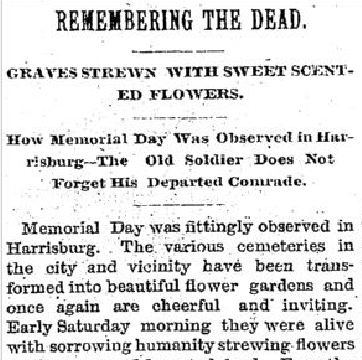
Harrisburg Patriot. 1 Jun 1891. Remembering the Dead. Graves Strewn with Sweet Scented Flowers. How Memorial Day Was Observed in Harrisburg – The Old Soldier Does Not Forget His Departed Comrades.
Memorial Day was fittingly observed in Harrisburg. The various cemeteries in the city and vicinity have been transformed into beautiful flower gardens and once again are cheerful and inviting. Early Saturday morning they were alive with sorrowing humanity strewing flowers on the graves of the departed dead. Even the humblest family, whose loved ones lie in secluded nooks in the potters’ field, carried a few flowers to the cold, cheerless mounds that mark their last resting place.
The sky was overcast with heavy clouds, but now and then the sun peeped between them and shed its warm rays over the earth. The best of order prevailed throughout the city, and the banks’ and many of the leading business houses were closed.
The main attraction of the day was the Grand Army and military parade, which formed at 1:45 o’clock on North Third Street, resting on North Street. The procession moved solemnly down third street in the following order:
Chief Marshal – Frank B. Kinneard. Aids – Charles Beaver, B. J. Campbell, J. W. Meese, William S. Decker, A. G. Cummings, Joseph Leonard, J. P. Crabbe. Eighth Regiment Drum Corps. City Grays – Captain J. B. Hutchinson. City Grays’ Cadet Corps – Captain John Hutter. Clergy. Paxton Military Band.
Post No. 58, G. A. R. – F. H. Hoy, Commander. Commonwealth Band.
Post No. 116, G. A. R. – Samuel Eberly, Commander. Brookwood Band.
Post No. 520, G. A. R. – H. S. Siegler, Commander.
Governor’s Troop, Lieutenant Fred M. Ott.
Conveyance with aged and crippled soldiers.
From Third Street the parade went down Market to Fourth, to Mulberry, to Derry, to Thirteenth, to State. Here Post No. 520 left the line and marched to Lincoln Cemetery….
Upon the conclusion of the ceremonies the commanders of the several organizations assumed charge of their commands and returned to the city….
————————–
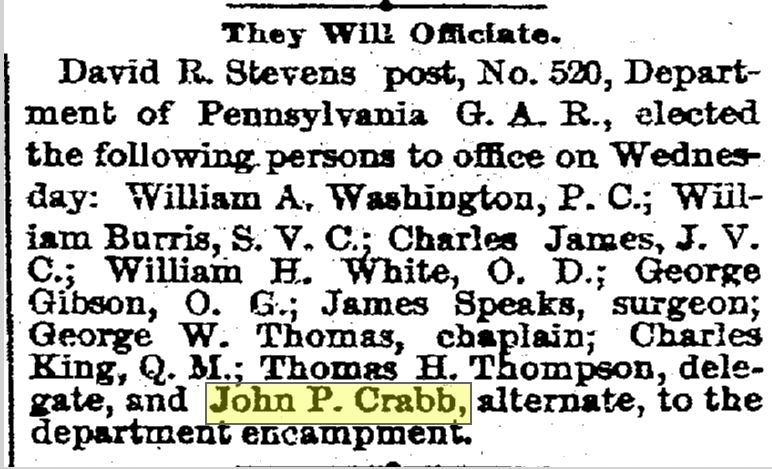
Harrisburg Patriot. 4 December 1891. They Will Officiate.
David R. Stevens Post, No. 520, G. A.R.,, elected the following persons to office on Wednesday: William A. Washington, Post Commander; William Burris, Senior Vice Commander; Charles James, Junior Vice Commander; William H. White, O. D.; George Gibson, O. G.; James Speaks, Surgeon; George W. Thomas, Chaplain; Charles King, Quarter Master; Thomas H. Thompson, delegate; and John P. Crabb, Alternate, to the department encampment.
—————————-

Harrisburg Patriot. 6 July 1892. Annual Campfire.
David R. Stevens Post No. 520, G.A.R., will hold its annual camp fire at Independence Island tomorrow evening. The committee of arrangements consists of J. W. Simpson, J. P. Crabb, David Stevens, Thomas Thompson, H. Adley, John Jackson, and George Gibson.
—————————-

Harrisburg Patriot. 20 September 1892. Representatives in Washington.
These representatives of Post No. 520, G. A.R., are in Washington: George W. Thomas, J. P. Crabb, J. W. Simpson, Daniel Montgomery, Daniel Affleberry and John Jackson.
—————————-
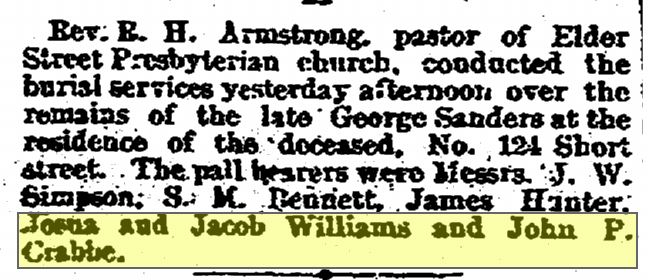
Harrisburg Patriot. 21 March 1893. Services for George Sanders.
Rev. R. H. Armstrong, pastor of Elder Street Presbyterian Church, conducted the burial services yesterday afternoon over the remains of the late George Sanders at the residence of the deceased, No. 124 Short Street. The pall bearers were Messrs. J. W. Simpson, S. M. Bennett, James Hunter, Joena and Jacob Williams and John P. Crabbe.
—————————-
Harrisburg Patriot. 31 May 1894. Soldiers’ Graves Decorated. How Memorial Day Was Observed in the Capital City. Grand Army Posts and Local Militia Turn Out to Honor the Memory of the Dead Veterans – Knights of the Golden Eagle to Observe the Day.
The graves in the cemeteries in Harrisburg of those who fell in battle for the Union, or have since died after having served their country on the fields of war were yesterday visited and decorated with flowers by their surviving comrades and by all those who appreciate what the dead veterans did. Memorial Day has come to be an occasion for the general remembrance of the dead and the graves of the soldiers were not alone yesterday in bearing tributes of flowers. In every cemetery there were bouquets and wreaths on the last sleeping place of many who never saw war, on the graves of the innocent children and gentle women, whose dreams were all of peace. The gentle shower of last evening will keep these flowers fresh for some time.
The day was observed as a legal holiday in this city. Banks were closed, and the doors of the departments of state government, with the exception of the executive and state departments were barred. The police station, however, was open as it is on every holiday….
The local Grand Army posts and the National Guard turned out in a body in the afternoon and marched to the cemetery where memorial services were held and the graves of the departed soldiers decorated….
Before the line of march was formed the ladies of the circle and auxiliary assembled at the rooms of Post No. 58 on North Third Street to make small bouquets of roses and carnations for the veterans to wear on their breasts. Each veteran was supplied alike and the entire membership was furnished a substantial lunch before starting the march….
The parade formed between one and two o’clock on West State Street, right resting on Second Street, and moved out State to Third, to Market, to Fourth, to State and to the cemetery in the following order: Detachment of Police…. Chief Marshal, Samuel Montgomery. Assistant Marshals, Captain William H. Crook, Post No. 58; Samuel Eberly, Post No. 116; Daniel Stephens, Post No. 520….
David R. Stephens Post, No. 520, with fifty comrades in line in command of Commander J. P. Crabb and headed by the Keystone Band, left the main column at the entrance to the Harrisburg Cemetery and marched to the Lincoln cemetery where this program was observed: Music, Keystone Band; Prayer, Rev. R. H. Armstrong; Reading of general Orders, Adjutant Stevens; Introductory Remarks, Major J. W. Simpson, Chairman Memorial Committee; Oration, Professor Howard Summers, Steelton; Singing, “America,” Ladies Circle, No. 35; Address, rev. Mr. Heard; Benediction, Rev. Mr. Moreland; Last Bugle Call, Miss Alice Gray.
Returning to the post room on the third floor of the Eby Building, Fifth and Market Streets, the veterans sat down to a lunch prepared by Ladies’ Circle No. 35….
—————————-

Harrisburg Patriot. 6 December 1894. Stevens Post’s New Officers.
David R. Stevens Post, No. 520, G.A.R., elected these officers last evening: Hezekiah Adley, Post Commander; Thomas H. Thompson, Senior Vice Commander; Walter Kelley, Junior Vice Commander; Charles Moore, Quartermaster; William Burris, Chaplain; William T. Lee, Officer of the Day; George Butler, Surgeon; William Stevenson, Officer of the Guard; Council of Administration, J. W. Simpson, J. P. Crabb, David R. Stevens; Delegates, John P. Crabb, J. W. Simpson.
—————————-
Philadelphia Inquirer. 19 May 1895. News of Interest to the Veterans. Completion of the General Program for the Services on Memorial Day. What Posts are Doing. Some of the Preparations Made by Various Organizations – More Resolutions Against the Confederate Monument – Appointments on the Staff of the Department Commander Recently Announced.
All the various details pertaining to the arrangements for Memorial Day were perfected….
On the proposed dedication of the Confederate Monument in Chicago on Decoration day, Post 116 of Duncannon, Pennsylvania, has this to say:
“Resolved, That we consider it a gross insult to the memory of our departed comrades and the survivors who fought in the Union cause for the upholding of the principles of this great American republic and the suppression of treason. No greater insult could be cast upon the memory of our lamented General John A. Logan, who instituted Memorial day, or no greater insult to the homes of our lamented Lincoln or Grant than to have the monument erected on its soil, much less for the man who instituted Memorial Day to perpetuate and pay sacred homage to the memories of our departed comrades and to strew over their last resting place the flowers of springtime.”
The following additional appointments on the staff of the Department Commander have been announced: Judge Advocate, Thomas A. Morrison…. James H. Levan, Minersville…. J. J. Cake, Pottsville…. Samuel Eberly, Harrisburg…. James D. Harris, Shamokin…. E. B. Jones, Selinsgrove…. J. P. Crabbe, Harrisburg….
—————————-
Harrisburg Patriot. 28 May 1895. Memorial Day. Details of the Big Parade – Where It Will March.
Memorial Day, Thursday, will be observed with the usual big parade by the local G.A.R. veterans. It will form on West State Street at 1:30 p.m., and will march down Third to Market, to fourth to State to the Harrisburg Cemetery. In the parade will be Chief marshal, E. P. Zinn, Post No. 58; Assistant Marshals, I. D. Winders, Post No. 58; John J. Gehrett, Post No. 116; J. P. Crabb, Post No. 520; aids from the different posts as the staff. City Grays, boys’ brigade, cornet band of Steelton; Post No. 58; Post No. 116, Sons of Veterans, Post No. 520, Governor’s Troop. After the exercises at the cemetery there will be a dinner to the veterans in Post 58’s hall in College Block.
—————————
Harrisburg Patriot. 30 May 1895. Memorial Day. It Will Be Observed as Usual in Harrisburg To-day – Program as Announces – Parade Will Move at Two O’Clock.
Memorial Day in Harrisburg will today be observed in a manner similar to that which has characterized its observance in years gone by. The surviving veterans will this afternoon march to the cemeteries in and about Harrisburg and there lay flowers on the graves of the comrades who marched by their side in war times. The old soldier feels that he has an unusual duty to perform in this direction and he will therefore lay aside his other duties today and march with his comrades to the cities of the dead, pick out the graves marked with the colores that cheered him at the head of the column years ago, lay on his tribute of love, drop a tear and silently return to his home.
The following program for the celebration of the day is announced: Assistant Marshals – I. D. Winters, Post No. 58; John J. Gehrett, Post No. 116; J. P. Crabb, Post No. 520. Aids, Post No. 58 – Isaac W. Gulles, M. A. Floyd, B. Briggles, E. W. Jackson, M. J. Royal, S. H. Kantz, C. F. Glenn, William Crook. Aids, Post No. 116 – J. D. Saltsman, Samuel Eberly, S. H. Barr, George L. Sellers, S. A. Pye, Henry Yohe, H. H. Swartz. Aids, Post No. 520 – George W. Stephens, William F. Lee, John Jackson.
The line will form at 1:30 on West State Street, right resting on Third, in the following order: Eighth regiment Drum Corps; City Grays; Boys’ Brigade’ Cornet Band of Steelton; Post No. 58. Post No. 116; Sons of Veterans; Post No. 520; Governor’s Tropop. The parade will move at two o’clock sharp over the following route: Third Street to Market, to Fourth, to State, to Harrisburg Cemetery.
The exercises at the cemetery will be as follows: Dirge, Steelton Band; Prayer, Rev. W. G. Ferguson; memorial services by comrades of the G.A.R.; firing salute by guards of Posts No. 58 and No. 116; taps by bugler.
—————————-
Harrisburg Patriot. 22 September 1896. The G.A.R. Parade. Chief Marshal Davis Issued His Final Orders Last Evening.
Major C. C. Davis, Chief Marshal of the big parade of Grand Army veterans to be held here Thursday as the commencement of the annual reunion of Central Pennsylvania veterans, last evening issued his final orders.
Mounted aides will report at headquarters, Lochiel Hotel, at eleven a.m., in full G.A.R. uniform with side arms, and at noon all posts from No. 1 to 214 inclusive will form on North Front Street, right resting on Marker, and will constitute the First Division. Second Division, consisting of Posts Nos. 215 to 415 inclusive, will form on North Second Street, right resting on Market; Third Division, consisting of Posts Nos. 415 to 635, will form on North Third Street, right resting on Marker. All unassigned G.A.R. members and old soldiers will form on South Third Street, right resting on Market, and will report to Special Division Aide, Lieutenant A. J. Fager, who will marshal that division.
At the sound of the bugle at one p.m., the command will move down Market to Fourth, up Fourth and Sixth to Reilly, down Reilly to Third, down Third to State, out State to Front, countermarch to Capitol Hill.
The following will be the appointments on the staff: Chief of Staff, E. P. Zinn; J. J. Zinn, Adjutant; Aides, W. H. Turner, of West Chester, Post No. 31; A. W. Moore, of York, Post No. 37;…. A. N. Davis and H. C. Demming, Post No. 58, this city; J. L. Leonard, J. A. Gardner, J. M. Gibbs, J. A. Steager, J. D. Diehl and J. D. Saltzman, Post No. 116 of this city;…. J. P. Crabbe, William T. Lee, T. H. Thompson, David Stevens, J. W. Simpson, and Walter Kelley, Post No. 520 this city; W. F. Raysor, W. O. Foster, H. A. Soper, F. E. Radle and Charles T. Charters.
Camp No. 15, Sons of Veterans, Drum Corps, will head the procession, and it is safe to say that they will in their usual style.
—————————-
Philadelphia Inquirer. 26 October 1896. Pension Certificates. Issue of 7 October 1896.
Pennsylvania – Original…. Benjamin F. Wright, Sunbury…. Elias Latsha, Rebucks…. Alexander McLaughlin, Enterline…. Franklin Diehl, Pine Grove…. William H. Crabbe, Philadelphia…. John P. Crabb, Harrisburg….
—————————-

Harrisburg Patriot. 12 May 1898. Colored Post in Line.
Stevens Post No. 520, Grand Army of the Republic of this city, has made preparations for the post’s participation in the exercises on Memorial Day, its committee being composed of Major W. Simpson, Chairman; J. P. Crabb, James M. Auter, Walter Kelley, David Stevens, Thomas Thompson and Joseph Jackson. The post will accompany the procession to the entrance of the Harrisburg Cemetery, after which it will proceed to Lincoln Cemetery, where W. Justin Carter will deliver an oration.
—————————-

Harrisburg Patriot. 4 Jul 1898. America’s Birthday. Program for the Celebration of the Fourth in the Good Old Fashioned Way – War Spirit Inspires to Patriotic Display of the Flag.
4:20 A.M. -Daybreak – One gun salute at Arsenal. ——– 4:40 A.M. – Sunrise – National salute of 21 guns and ringing of bells. ——– 6:00 A.M. – Religious services at churches at which time it is recommended that the Declaration of Independence be read. ——– 8:00 A.M. – Ringing of chimes. ——– 10:00 A.M. – Precisely, street parade. Notice of starting to be given by the sounding of bugles, and thirteen tolls by the Court House bell. ——– 12:00 M. – Salute of 45 guns. ——– 3:00 P.M. – Bicycle races, picnicking at Hoffman’s Woods, baseball at Susquehanna Rounds. ——– 5:00 to 7:30 P.M. – Band concert at Reservoir Park, and display of daylight fireworks….
The big thing will be the parade…. the list of aids is as follows…. Colonel Henry C. Demming, Chief Marshall; Chief of Staff, Major Finn I. Thomas; Special Aides… John P. Crabb….
—————————
Harrisburg Patriot. 10 September 1898. No News of Troopers. Enthusiasm of Welcoming Citizens Running High.
Up to an early hour this morning the city authorities and state officers had heard nothing from the long expected Governor’s Troop and it is believed that the cavalrymen will not arrive in the city before Sunday or Monday. The troopship is some time overdue, but no anxiety s felt, as there have been no storms to endanger the vessel. Should the boys get here tomorrow they will get just as warm a reception as though they had arrived on a week day as all the heads of departments including both Governor Hastings and Mayor Patterson, agree in saying that they will turn out to meet the returning warriors and all the organizations will be in line according to program.
The general sentiment expressed is that the duty of meeting and greeting the men who so willingly risked death and worse than death for the country’s honor is not alone a privilege but a holy duty and one wholly in keeping with the sanctity of the Sabbath. The course is approved by act of the prominent citizens of town who have been consulted.
By special invitation will be present at the welcoming: Captain A. Wilson Norris, Sergeant Major Gilbert, E. Dale Daugherty and the 8th Regiment Drum Corps. Major Joseph B. Hutchinson and Captain Laubenstein and Company D.
The line of procession as agreed upon yesterday is as follows: Police Band; Reception Committee; Citizens’ Corps; C. E. Brigade; Epworth Guards; Sons of Veterans: Band; Union veterans’ Union; G.A.R. Post No. 520; G.A.R. Post No. 116; G.A.R. Post No. 58. The above will form on Market Street, east side, right resting on Fourth. Band; Fire Department. The Fire Department will form on South Fourth Street, right resting on market.
Chief-of-Staff, Major Charles C. Davis; Aides, Colonel H. C. Demming, Major John T. Ensminger, Captain James B. McCalley; John W. German, Joseph J. Leonard, Ed B. Dies, John P. Crabbe….
The ex-members of the Governor’s Troop met last evening to perfect arrangements for a grand turn out to honor the cavalry heroes of the Porto Rican Expedition. The men were instructed to assemble at Russ Hall at the sound of the court house bell. Badges will be furnished each ex-member….
—————————–
It is believed that John Peter Crabb died in 1901.
News articles are from the on-line resources of the Free Library of Philadelphia. Only a portion of some of the original articles is shown. The complete articles are available in the project files.
It is hoped that presenting these articles, which include the names of many of John Peter Crabb‘s contemporaries, that someone will come forward with more information on the Stevens Post G.A.R., No. 520 of Harrisburg – perhaps even some pictures of post members or of some the late 19th century Memorial Day parades in Harrisburg. Comments are welcome to this post.
Category: Research, Resources, Stories |
1 Comment »
Tags: African American, G.A.R., Gratz Borough
 ;
;
